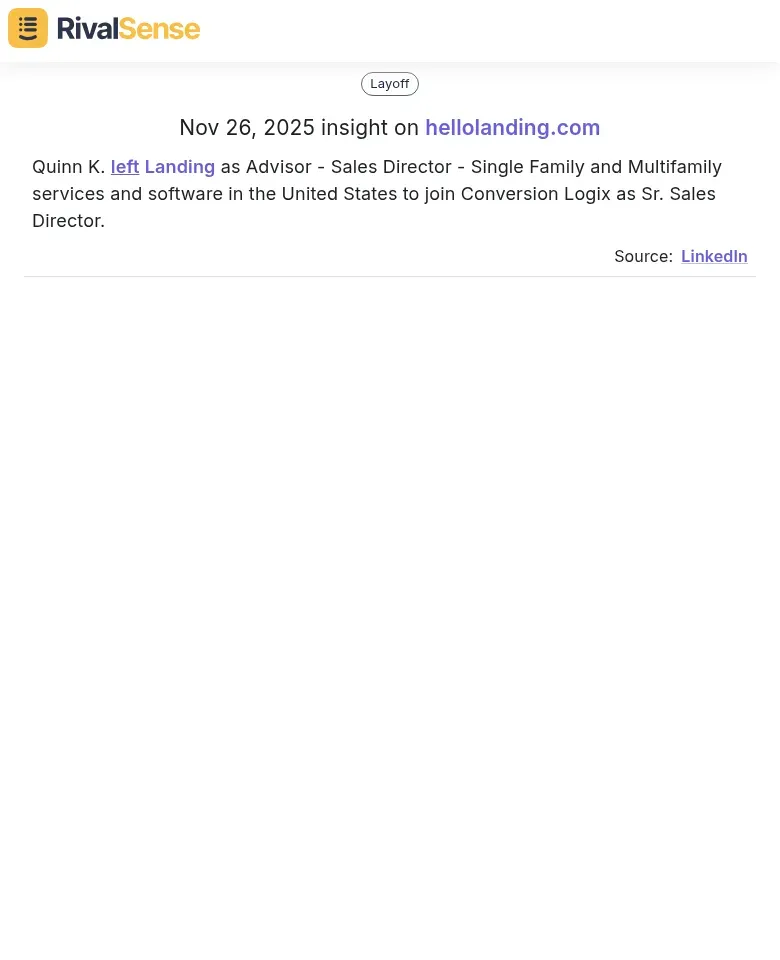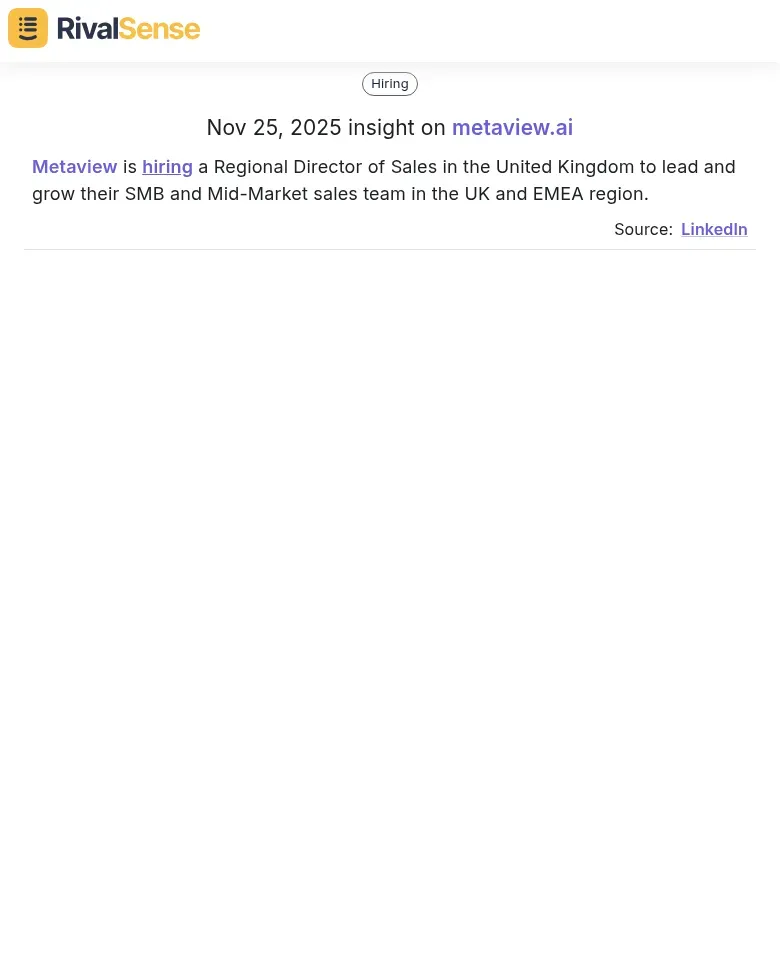How to Track Competitor Funding for Supply Chain Optimization
In today's fast-paced business environment, staying informed about competitor funding is essential for maintaining a competitive edge. Competitor funding tracking involves monitoring how rivals secure capital—from venture rounds to debt financing—and analyzing how they allocate these resources toward supply chain enhancements. This intelligence reveals strategic priorities: a competitor raising $50M for warehouse automation signals a push for efficiency, while funding for logistics tech indicates a focus on delivery speed. These insights help you anticipate market shifts, like when multiple players invest in sustainable sourcing, highlighting emerging trends.
Ignoring competitor funding creates blind spots that can leave your supply chain reactive rather than proactive. Without tracking, you might miss critical moves like a rival scaling distribution networks or adopting AI-driven inventory systems. To start, set up alerts for competitor SEC filings, press releases, and Crunchbase updates. 📈 Create a simple checklist to ensure you're always prepared:
- Note funding amounts and investors
- Document stated use cases (e.g., 'supply chain digitization')
- Track timelines for implementation
This practical approach helps you adapt your strategy and maintain a leadership position in your industry.
Methods for Tracking Competitor Funding
Effective competitor funding tracking requires a multi-faceted approach to gather accurate and timely data. By combining various sources and tools, you can build a comprehensive view of your rivals' financial moves and their implications for supply chain optimization. Here’s how to do it efficiently:
1. Use Financial Databases & News Sources 📊
Set up real-time alerts on platforms like Crunchbase, PitchBook, and Bloomberg to catch funding announcements as they happen. Monitor news aggregators for related updates, and create keyword alerts for competitors' names plus terms like 'series funding' or 'capital raise'. Tip: Dedicate time each week to review these sources to stay ahead of trends.
2. Analyze SEC Filings & Public Disclosures 📄
Regularly check the SEC EDGAR database for Form D filings (private placements) and S-1 filings (IPOs). Public companies disclose funding details in quarterly reports (10-Q) and annual reports (10-K). Use this checklist to streamline your analysis:
- Review debt issuances and equity offerings
- Note merger filings for capital injection clues
- Cross-reference with press releases for context
3. Leverage AI Tools & APIs 🤖
Automate your tracking with AI-powered platforms like RivalSense, which scrape funding data from multiple sources to deliver consolidated insights. Integrate APIs from financial data providers into your dashboard for real-time alerts. Practical step: Set up automated weekly reports on competitor funding rounds, amounts, and investors to save time and reduce manual errors.
Example: If a logistics competitor raises $50M, analyze how they might invest in warehouse automation—allowing you to adjust your supply chain strategy proactively and avoid being caught off guard.
Analyzing Funding Data for Supply Chain Insights
Analyzing competitor funding data goes beyond mere numbers; it uncovers actionable insights into how rivals are scaling and optimizing their supply chains. By correlating funding rounds with operational changes, you can predict shifts in logistics, technology adoption, and market expansion. For instance, a Series B raise often precedes geographic expansion, enabling faster delivery times and improved customer satisfaction.
Identify key investments in technologies like IoT for real-time tracking or AI for demand forecasting, as these can significantly boost efficiency and reduce costs. Assess how funding impacts capabilities: large rounds may lead to competitive pricing, optimized inventory via predictive analytics, or enhanced last-mile delivery. Follow these practical steps to turn data into strategy:
- Monitor sources like Crunchbase or SEC filings for funding details.
- Cross-reference with news on facility openings or tech deployments.
- Use automated tools such as RivalSense to set alerts for funding-related moves and streamline analysis.
Tip: Focus on late-stage funding, as it frequently fuels aggressive supply chain overhauls that can disrupt markets and require swift responses from your team.
Integrating Funding Intelligence into Supply Chain Strategy
Integrating funding intelligence into your supply chain strategy transforms raw data into a powerful competitive advantage. When competitors secure significant funding, they often launch expansions, new products, or market entries that directly impact supply chain dynamics. By anticipating these moves, you can proactively adjust your operations to mitigate risks and seize opportunities.
Adjust Procurement & Supplier Relationships:
- Monitor competitor funding rounds to predict increased demand for raw materials or components. If a rival raises capital for expansion, secure long-term contracts with key suppliers to lock in favorable terms and prevent shortages.
- Example: If a competitor's Series B funding targets production scaling, negotiate volume discounts with suppliers to maintain cost leadership and ensure stable supply chains.
Optimize Inventory & Distribution:
- Use funding alerts to forecast competitor market entries. If they invest in logistics, preemptively optimize your inventory levels—reduce stock for overlapping products to avoid overstocking, and expand distribution networks in underserved regions they might target.
- Tip: Implement a dynamic inventory system that adjusts reorder points based on competitor funding news, ensuring agility and reducing waste. 📦
Develop Contingency Plans:
- Funding often leads to supply chain disruptions, such as competitor hoarding resources. Create backup plans by identifying alternative suppliers, diversifying logistics partners, and building buffer stocks for critical items.
- Checklist for risk mitigation:
- Regularly review competitor funding reports
- Assess potential ripple effects on your supply chain
- Update strategies quarterly to stay responsive
By embedding this intelligence into decision-making, you turn competitor actions into chances for resilience and growth.
Tools and Best Practices for Effective Tracking
Tracking competitor funding effectively demands the right tools and consistent practices to ensure accuracy and relevance. Implement dedicated competitive intelligence software like RivalSense for continuous monitoring of funding rounds, investor updates, and regulatory filings. These platforms automate data collection from diverse sources, reducing the risk of missing critical developments that could affect your supply chain.
Establish a routine to maintain discipline in your tracking efforts: conduct weekly funding reviews, hold monthly team briefings to discuss insights, and perform quarterly strategy assessments. Create a verification checklist to ensure data integrity:
- Confirm funding amounts and investor profiles
- Document use of funds and projected timelines
- Cross-reference with Crunchbase, PitchBook, and official announcements
Maintain ethical compliance by relying solely on publicly available information, such as press releases, regulatory filings, and investor presentations. Document your methodology to promote transparency and avoid legal pitfalls.
Practical tip: Set up automated alerts for specific competitors and funding thresholds using tools like RivalSense. This enables you to benchmark your own supply chain investments and identify emerging market trends before they become widespread.
Beyond Funding: Other Competitor Moves to Monitor
While tracking funding is crucial, other competitor activities offer valuable insights that complement your intelligence efforts. Monitoring product launches, personnel changes, and hiring patterns can reveal strategic shifts and emerging threats. For example, a new product rollout might indicate a focus on innovation, while key hires could signal expansion into new markets or technologies.
Using RivalSense, we observed that Starship Technologies UK Operations Manager Dan J. announced on November 26 that the company installed its first wireless charger in Leeds, enabling its robots to deliver hot food for Uber Eats. 
This type of product launch insight is valuable because it highlights innovation and potential market disruptions, allowing you to anticipate new services that could impact your supply chain logistics and customer expectations.
In another instance, Quinn K. left Landing as Advisor - Sales Director - Single Family and Multifamily services and software in the United States to join Conversion Logix as Sr. Sales Director. 
Management changes like this are valuable as they often indicate strategic realignments or new priorities, helping you adjust your own talent strategies and competitive positioning to stay aligned with industry movements.
Additionally, Metaview is hiring a Regional Director of Sales in the United Kingdom to lead and grow their SMB and Mid-Market sales team in the UK and EMEA region. 
Hiring announcements provide clues about growth plans and market expansions, enabling you to prepare for increased competition in specific regions and refine your supply chain to support potential new customer segments.
Conclusion: Leveraging Insights for Competitive Advantage
Tracking competitor funding and other key moves transforms supply chain management from a reactive process to a proactive strategy. By monitoring investment rounds and related activities, you can anticipate competitors' capacity expansions, technology upgrades, and market entries before they fully unfold. This foresight allows you to adjust your supply chain—whether through securing alternative suppliers, investing in automation, or expanding distribution networks—ahead of market shifts.
Integrating these insights into your long-term business strategy ensures sustained competitive advantage and agility. Use the data to identify emerging trends, such as investments in sustainable logistics or AI-driven inventory management, and align your roadmap accordingly. Regularly update your competitive intelligence dashboard with alerts from tools like RivalSense to stay responsive and informed.
Practical steps to embed this into your operations:
- Set up automated alerts for competitor funding and other moves using reliable platforms.
- Analyze use cases to predict supply chain impacts, like new warehouses post-funding.
- Conduct quarterly reviews to adapt strategies based on aggregated insights.
- Foster cross-department collaboration to leverage intelligence across procurement, logistics, and planning teams.
Embrace ongoing adaptation; market leadership hinges on staying ahead of disruptions driven by competitor actions. By making tracking a core habit, you'll not only optimize your supply chain but also solidify your position as an industry frontrunner.
Ready to put these strategies into action? Try RivalSense for free at https://rivalsense.co/ and get your first competitor report today to start gaining actionable insights for your business!
📚 Read more
👉 How Vanta's Middle East Move Spurred Competitor Action
👉 How Website Changes Reveal Competitor Strategies for Key Accounts
👉 Key Account Engagement Checklist for Roofing CRM Success
👉 Product Offering Competitor Analysis: Template & Framework
👉 Leveraging Competitor Executive Changes for Strategic Insights
